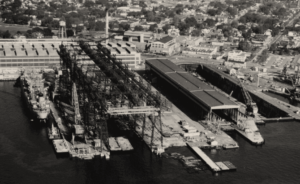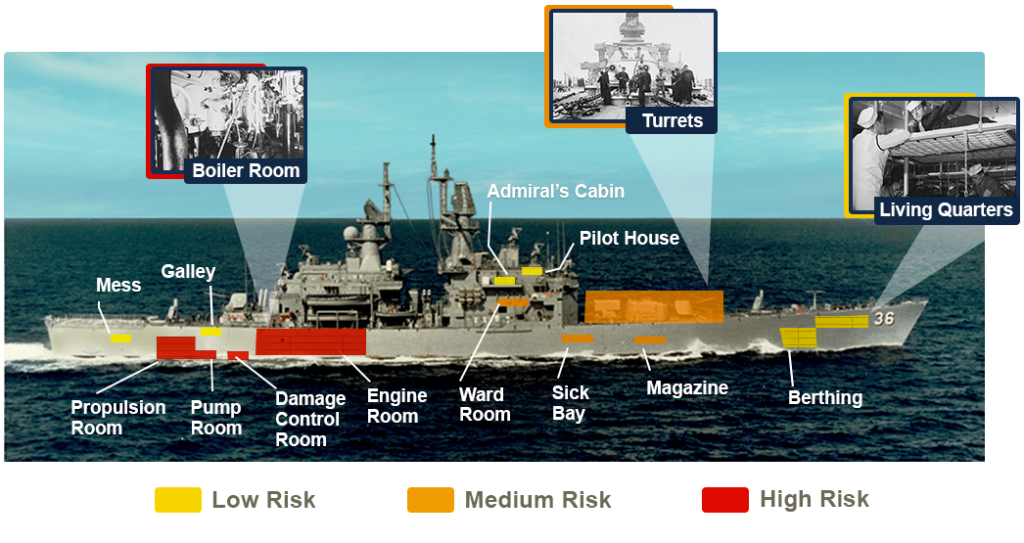Shipyards have been the sites of some of the highest levels of asbestos exposure. Asbestos was used in most aspects of shipbuilding. As a result, U.S. Navy personnel and shipyard workers were regularly exposed to asbestos in shipyards and many developed mesothelioma later in life.
Did Shipyards Put People at Risk of Asbestos Exposure?

Yes, anyone who worked in a shipyard between the 1930s and early 1980s was at risk of asbestos exposure.
It's believed that 4.5 million people were exposed to asbestos in shipyards during World War II alone, according to a New York Times report.
Tons of asbestos-containing products were used to build almost every U.S. Navy ship and countless civilian vessels during this time.
Shipyards kicked up so much asbestos dust that workers couldn't see across the room in many cases. This exposure put workers in danger of mesothelioma and other asbestos-caused cancers later in life.
33% of all mesothelioma cases today can be traced back to shipyard work or service in the U.S. Navy.
Former Navy or civilian shipyard workers with mesothelioma may qualify for medical care and compensation. Veterans with mesothelioma can also access life-changing benefits from the U.S. Department of Veterans Affairs (VA). Learn about all the benefits available with our Free Veterans Packet.
Why Was Asbestos in Shipyards?
Asbestos-containing insulation helped protect Navy ships and other vessels from combustion and fire damage. Additionally, asbestos did not corrode or wear down in the sea and were not electrically conductive.
The general public and military weren't aware that asbestos caused cancer as manufacturers of asbestos-based products hid the risks.
Asbestos was found in these shipyard materials and equipment:
- Boilers
- Bulkheads
- Flooring and ceiling materials
- Gaskets
- Insulation
- Lagging cloth
- Machinery casings
- Paint and glue
- Wrapping on high-pressure pipes
Shipyard work involved installing asbestos-containing products such as the ones listed above and replacing older parts as they wore out, which released asbestos fibers into the air.
The human body can't break down asbestos fibers. If a shipyard worker breathed in or swallowed the fibers, they could suffer long-term irritation. This can cause mesothelioma tumors could form 10-50 years after exposure.
Asbestos-containing ship parts were used throughout military and civilian ships, putting shipyard workers and U.S. Navy veterans at a high risk of exposure. View where asbestos components were used aboard Navy ships below.


High-Risk Shipyard Asbestos Jobs
Anyone who worked with or around asbestos in shipyards throughout the 20th century was at risk of exposure. That said, some shipyard workers were in greater danger than others.
Shipyard jobs with the highest risk of asbestos exposure included:
- Boiler workers
- Civilian contractors
- Clerical workers
- Electrical engineers
- Electricians
- Government officials and inspectors
- Insulators
- Maintenance workers
- Naval architects
- Naval officers
- Nautical and structural engineers
- Painters
- Plumbers
- Steamfitters
- Tilers
- Welders
The risks were particularly high among U.S. Navy shipyard workers. Government requirements meant that nearly every Navy ship used asbestos-containing materials aboard.
Sadly, by the time the risks of asbestos exposure became public knowledge, it was too late for the millions of shipyard workers and Navy personnel exposed to asbestos.
Each year, approximately 1,000 shipyard workers and Navy veterans develop mesothelioma. Many others go on to develop other asbestos-caused diseases like lung cancer or asbestosis due to shipyard work.
Contact us if you suffered asbestos exposure in shipyards and now have mesothelioma. Our team can help you access medical care and financial aid.
List of Asbestos Shipyards
Hundreds of shipyards relied on asbestos-containing products, including dozens controlled by the U.S. Navy. View a partial list of these shipyards below.
- Avondale Shipyards (Louisiana)
- Barnes Riverside Shipyard (Minnesota)
- Banks Shipyard (New Jersey)
- Bethlehem Steel Shipyards (various)
- Bayou Black Shipyard (Louisiana)
- Bloodworth Shipyard (Texas)
- Brunswick Shipyard (Georgia)
- Charleston Naval Shipyard (South Carolina)
- Defoe Shipyard (Michigan)
- Delair Shipyard (New Jersey)
- Denton Shipyard (South Carolina)
- Dravo Shipyard (Delaware)
- Erie Basin Dry Dock (New York)
- Eureka Shipyard (New York)
- Evansville Shipyard (Indiana)
- Gulf Shipyard (Alabama)
- Hoboken Shipyard (New Jersey)
- Howard Shipyard (Indiana)
- Ingalls Shipbuilding (Mississippi)
- Joliet Shipyard (Illinois)
- Long Beach Naval Shipyard (California)
- Long Island Shipyard (New York)
- Lorain Shipyard (Ohio)
- Marco Shipyard (Washington)
- Marietta Shipyard (Ohio)
- Mayport Naval Shipyard (Florida)
- Moss Point Shipyard (Mississippi)
- National Steel Shipbuilding (California)
- Newport News Shipbuilding (Virginia)
- Philadelphia Naval Shipyard (Pennsylvania)
- Portsmouth Naval Shipyard (Maine)
- Puget Sound Naval Shipyard (Washington)
- Quaker Shipyard (New Jersey)
- Richmond Shipyard (California)
- Seneca Shipyards (Illinois)
- Sampson Naval Shipyard (Delaware)
- Simpson Shipyard (Massachusetts)
- Smith Shipyard (Florida)
- Stockton Shipyard (California)
- Thames Shipyard (Connecticut)
- Todd Shipyards (various states)
- United States Coast Guard Yard (Maryland)
Did you work at a shipyard that's not listed? Our team can still help you access mesothelioma benefits. Get started with a Free Veterans Packet.
California Shipyards and Asbestos
California had more shipyards that relied on asbestos than any other state. As a result, mesothelioma is prevalent among former California shipyard workers.
California shipyards that used asbestos include:
- Bethlehem Steel Shipyard
- California Naval Shipyard
- Consolidated Steel Shipyard
- Fulton Shipyard
- General Dynamics
- Hunters Point Naval Shipyard
- Long Beach Naval Shipyard
- Richmond Shipyard
- San Diego Naval Shipyard
- Moores Dry Dock Company
- Stockton Shipyard
- Todd Pacific Shipyards
California is also home to many natural deposits of asbestos. The asbestos was mined and made into products used by the California shipbuilding industry.
New York Asbestos Shipyards
On the East Coast, New York was a major player in the shipbuilding industry, with multiple shipyards across the state. Unfortunately, those who served in these shipyards could have easily been put at risk of asbestos exposure.
The following New York shipyards used asbestos:
- Arthur Blair Shipyard
- Atlantic Basin Shipyard
- Bethlehem Steel Shipyard
- Blair Shipyard
- Brooklyn Navy Yard
- Defoe Shipbuilding Company
- Robert Jacob Shipyard
- Jakobson Shipyard
- Reynolds Shipyard Corporation
- Todd Shipyard
If you worked in a shipyard in New York or in any other state and now have mesothelioma, you may qualify for compensation — even if the shipyard is not listed above. Contact us now to learn more and get help.
Compensation for Shipyard Workers With Mesothelioma
Shipyard workers who developed mesothelioma can now seek key resources, including VA benefits, financial compensation, and medical care.
VA Benefits
Shipyard workers who served in the U.S. Navy or any other military branch can file for VA benefits following a mesothelioma diagnosis.
The VA pays out over $4,000 per month to married veterans with mesothelioma in most cases.
We can help you file for or increase your mesothelioma VA benefits right now.
VA Health Care Services
Military shipyard workers with mesothelioma can get free or low-cost VA health care as part of their veterans benefits. This allows veterans to save money on medical treatments, which could otherwise be very expensive.
Need help connecting with a mesothelioma doctor? Call (877) 450-8973 now. We can help you find top doctors and treatments faster.
Legal Compensation for Shipyard Asbestos Exposure
Shipyard workers suffering from mesothelioma can file asbestos lawsuits or asbestos trust fund claims. The average mesothelioma settlement is $1 million or more and payouts often start in 90 days or less.
These legal actions will demand compensation from private companies that made and sold asbestos-containing products without disclosing the health risks. The U.S. military isn't sued and you can still file for VA benefits alongside legal claims.
We're Here to Help U.S. Shipyard Workers With Mesothelioma
Every year, thousands of people who worked in shipyards decades ago develop mesothelioma and other asbestos-related illnesses.
These health issues could have been prevented if manufacturers of asbestos-containing products had disclosed the dangerous truth rather than hiding it to make a profit.
The Mesothelioma Veterans Center proudly helps both eligible veterans and civilians who worked in shipyards access VA benefits, treatments, and financial compensation following a mesothelioma diagnosis.
Learn about all the ways we can help you and your family in our Free Veterans Packet.
Asbestos in Shipyards FAQs
Is there asbestos in shipyards?
Yes. Over 20 different states were home to dozens of shipyards that relied on asbestos between the 1930s and early 1980s.
Any shipyard worker exposed to asbestos could develop mesothelioma or another deadly asbestos-related disease later in life.
For example, cases of shipyard workers with lung diseases and lung cancer are common due to asbestos.
What is the shipyard lung disease?
Pleural mesothelioma is a notable lung-related disease that affects many shipyard workers.
This illness develops 10-50 years after exposure to asbestos fibers, and products containing asbestos were used for decades in shipyards.
Contact us now for help pursuing VA benefits, treatments, and compensation if you developed mesothelioma from asbestos exposure in shipyards.
Is asbestos still used in shipbuilding?
Asbestos is no longer used in shipbuilding today due to the health risks. But, prior to the early 1980s, millions of shipyard workers were exposed to asbestos on a daily basis.
It takes 10-50 years to develop mesothelioma after asbestos exposure, so you could be in danger even if you were exposed long ago.
What are the dangers of working in a shipyard?
Prior to the early 1980s, one of the biggest dangers of working in a shipyard was exposure to asbestos.
Shipbuilding involved removing, installing, and repairing ship components that contained asbestos. These activities could release asbestos fibers and dust into the air, and anyone who breathed in or swallowed them was put at risk of mesothelioma.
Can you sue the U.S. Navy for asbestos exposure?
You can't file mesothelioma lawsuits against the U.S. Navy or the U.S. government. However, you can sue the manufacturers of asbestos-containing products you were exposed to while serving.
You can still apply for mesothelioma VA benefits even if you have filed an asbestos lawsuit.
Get our Free Veterans Packet to learn more about your legal and financial options after a mesothelioma diagnosis.


